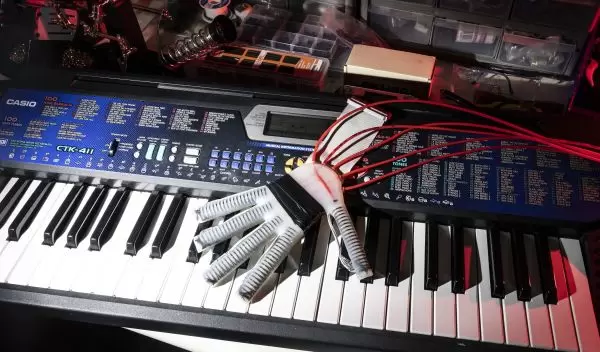
Robotic glove that 'feels' lends a hand to relearn playing piano after a stroke
For people who have suffered neurotrauma such as a stroke, everyday tasks can be extremely challenging because of decreased coordination and strength. These problems have spurred the development of robotic devices to help enhance their abilities. However, the rigid nature of these assistive devices can be problematic, especially for more complex tasks such as playing a musical instrument.
A first-of-its-kind robotic glove is lending a "hand" and providing hope to piano players who have suffered a disabling stroke. Developed by researchers from Florida Atlantic University, the soft robotic hand exoskeleton uses artificial intelligence to improve hand dexterity. This research was supported in part by two grants from the U.S. National Science Foundation. Results of the study are published in Frontiers in Robotics and AI. See a video of the robotic glove in action.
Other soft robotics have been used to play the piano, but the newly developed robotic glove is the first to "feel" the difference between correct and incorrect versions of the same song and to combine these features into a single hand exoskeleton.
"Playing the piano requires complex and highly skilled movements, and relearning tasks involves the restoration and retraining of specific movements or skills," said FAU's Erik Engeberg, senior author of the paper. "Our robotic glove is composed of soft, flexible materials and sensors that provide gentle support and assistance to individuals to relearn and regain their motor abilities."
Researchers integrated special sensor arrays into each fingertip of the robotic glove. Unlike prior exoskeletons, this new technology provides precise force and guidance in recovering the fine finger movements required for piano playing. By monitoring and responding to users' movements, the robotic glove offers real-time feedback and adjustments, making it easier to grasp the correct movement techniques.
To demonstrate the robotic glove's capabilities, researchers programmed it to feel the difference between correct and incorrect versions of "Mary Had a Little Lamb." To introduce variations in the performance, they created a pool of the song played with no errors and with different types of errors.
"Importantly, although this study's application was for playing a song, the approach could be applied to myriad tasks of daily life, and the device could facilitate intricate rehabilitation programs customized for each patient," said Engeberg.
